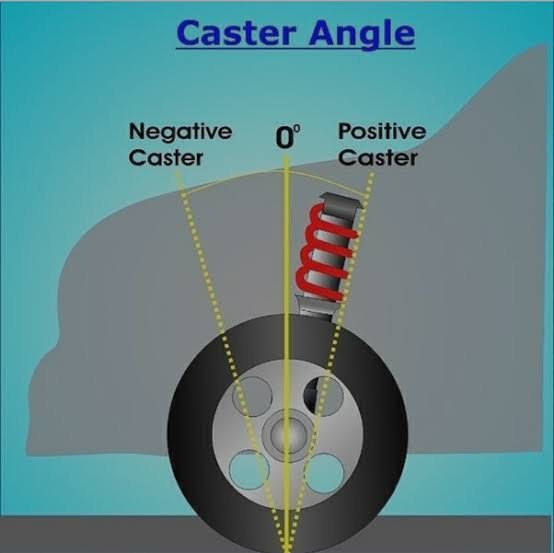Wheel Alignment
It refers to the angular relationship
between the front wheels and parts
attached to it with that of car frame.
Wheel alignments ensure that all four
wheels are consistent with each other
and are optimized for maximum contact with the surface of the road.
Aim of wheel alignment
1. To turn the steered wheel easily and to
ensure vehicle directional stability.
2. To reduce the tyre wear to a minimum

Angles in wheel alignment
1. Caster Angle
2. Camber Angle
3. King pin inclination
4. Toe-in and Toe-out
Caster Angle

The angle between the king pin
centre line (or steering axis) and the
vertical axis, when viewed from the side of the vehicle, is called the Caster angle. Caster angle is about 2º to 3º.
Importance of Caster Angle
1. Positive Caster provides directional
stability.
2. To prevent pulling of wheel on one
side during braking
3. To reduce the tyre vibration
Camber angle

The angle between the centre line of
the tyre to the vertical line when viewed from the front of the vehicle is known as Camber. It is approximately 1º to 2º.
Importance of Camber Angle
1. At the time of turning, camber angle
ensures the ease of steering.
2. To reduce the tyre wear.
3. To reduce the load acting on the king pin and the wheel bearing due to
weight of the vehicle.
King Pin Inclination


When the vehicle is viewed from
front, the angle between the inclination of the king pin from the vertical axis is called the King pin Inclination. The inclination is normally kept 7º to 8º.
The reason for king pin inclination
1. It gives good road holding on turnings.
2. It reduces steering effort.
3. It reduces the load acting on the wheel bearing.
Toe-in and Toe-out
 When viewed from the top, the
When viewed from the top, the
distance between the front wheels at the front is less than the distance at the back is called Toe-in. Normally toe-in is up to 3 mm.
Toe-out
 When viewed from the top, the distance between the front wheels at the front is more than the rear side is called toe-out
When viewed from the top, the distance between the front wheels at the front is more than the rear side is called toe-out
Effects of improper wheel alignment
1. Vehicle will roll over due to centrifugal force acting at the time of turning
2. Wheels are subjected to vibration
3. Increases the tyre wear
4. Reduce the tyre life
5. Hard steering
6. Vehicle pull on one side




